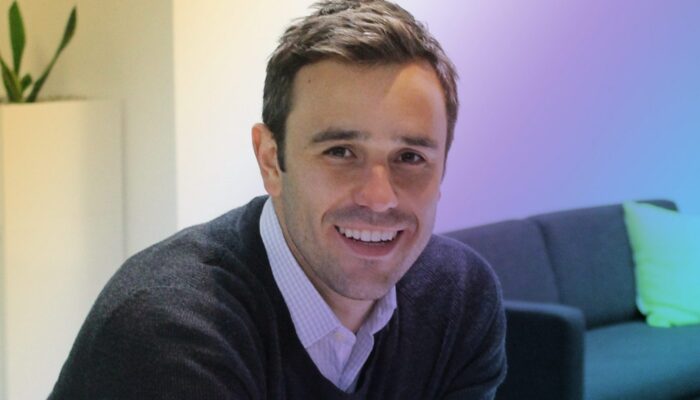It’s that time of year again, folks. Time to review the personal finance apps that…
Investing Lessons From Sydney’s Coolest Robo-Adviser

Back in the day, before ‘Fintech’ was a buzzword, Chris Brycki pulled up stumps at his investment banking job and decided that there had to be a better & fairer way for average folks to access sensible but clever financial advice and investment options.
And so he created Stockspot, which could reasonably lay claim to being Australia’s first robo-advisor – a financial advice firm that profiles you as a customer and then automatically allocates an appropriate investment portfolio. In doing this and by investing largely in low-cost ETFs (electronically traded funds), less of your investment goes towards management fees and more going into your investment (don’t worry, Chris does a much more eloquent job of explaining it further on in the article).
It’s a disarmingly simple approach and one that echoes the investment strategies of luminaries such as Warren Buffett, Tony Robbins (via his book ‘Money – Master The Game’) and, to a certain extent, our dear old Barefoot Investor here in Australia.
And yet because the beauty lies in the simplicity of the portfolios, it’s an approach that flies in the face of ‘active’ investment management (translation: paid for), the very industry in which Brycki used to ply his trade.
If this wasn’t enough, Stockspot also produces an annual Fat Cat Report that reviews the performance of Australia’s superannuation (pension) industry, effectively giving a thumbs-up to the best performing (versus the fees they charge) funds and big fat custard pie in the face to those that are shafting their customers. [The superannuation industry makes around $23bn per year in fees from average customers like you or I, a figure which Brycki thinks could be halved with no effect on overall performance].
I sat down with Chris after a robust game of ping-pong and asked him some questions.
SFD – Tell us a bit about your ‘first’ career as a banker. How you got into it? How long you were doing it? Who you worked for?
Chris – My first ‘graduate’ job was as a portfolio manager at UBS managing the banks money. A pretty cool job for a young kid to end up in. But really I got into trading shares much younger – I started when I was 10 and Dad showed me the stock market sheets of the newspaper, from there I was hooked.
At school I played the ASX share game every year (and was lucky to win it a few times), before I continued to learn while at a hedge fund where I traded shares while at uni. So really I was involved in the ‘active’ side of share trading and investing for about 15 years until I was 26 when I had my ‘a-ha’ moment. When I realised that for most people, trying to beat the share market was not a game worth playing and that there was a better way to invest.
SFD – Can you explain the genesis of Stockspot, because it seems almost as if there’s this metamorphosis in which you’ve gone from Gamekeeper to Poacher almost and not the other way around which we’d usually expect? You’ve actually gone from a corporate behemoth to representing the average punter, or at least the average investor.
Chris – Working in the finance industry, it became pretty clear to me that the only people that did really well out of shares were the people selling investing products and services, not the people buying them.
And it’s not a new phenomenon either, in fact there’s a fantastic book that was written in 1940 that came to the same conclusion called ‘Where are all the customers yachts’.
The reason: most financial products and services are wonderful at generating fees, commissions and brokerage for those earning them, but terrible at helping the average punter who uses them.
For 99% of the population they’d be better off simply investing in the market itself via an index fund and doing absolutely nothing else. Yet very few people in the finance industry share this key insight because their jobs depend on you not finding out. It’s a principal-agent problem.
SFD – In terms of actually making the switch from UBS to setting up Stockspot, what was the timeline? Did you run SS on the side for a while? And how did you fund, say, the first 6 and then 12 months. I kind of want to get into the weeds a little bit and understand the minutae of that initial period (if you’re happy to share it).
Chris – You do hear about great businesses that started from ‘side hustles’ and maybe they work out for some people, but for me I needed the time (and motivation) to be fully focused on Stockspot.
So when I started the business in 2013 I stopped all my other work and focused on it fully. It was a pretty tough and isolating first year working at home – with no colleagues, no customers and no funding.
But at the same I learned there’s no better motivator than no income and seeing your bank balance go backwards!
SFD – And so you get your ducks in a row and you’re ready for business, and you open the Stockspot doors…what happened next? Are there crickets? Is there a flood of customers rushing the doors? Did a bell ring every time a new customer deposited funds like they had a Netflix? Describe those first few weeks and months after launch and did it run to projections?
Chris – Yep, crickets. It’s certainly a misconception that I had about starting a business. I thought that if your idea was good enough, as soon as you opened your doors the customers would come flooding in. The reality is very different, it takes a lot work to build trust, traction and a track record before people are willing to give your product a go. But the best thing about starting slow is that you’ve got plenty of time to get feedback from your first customers – and it’s that feedback from those first customers that really shaped what our product looks like today.
SFD – Let’s shift gears a little bit and talk about the ‘Fat Cat Report’. Whose idea was that, what was the motivation behind it and what was the initial reception? It seems like it could be a fairly dangerous idea for someone in your line of work.
Chris – Just as some background for your readers – The Fat Cat Funds Report (click on link to request your own copy of the report – SFD) is research we publish on the performance of superannuation funds. We name the best performers but also shame the worst. I first did the research the year I started Stockspot, in 2013, and we’ve published it every year since.
As a kid I admired people like ‘Aussie John’ who started businesses that wanted to give the little guy a fair-go. He showed how people could be doing much better with the mortgages and I thought the same needed to be done for people’s investments and super.
The academic research supports that most people should not be paying high fees for other people to manage their money – including in super- but nobody in the industry has an incentive to say it because they all feed from the same trough.
Meanwhile super / pensions is hardly an exciting topic because you don’t see the benefits for many years. The Fat Cat Report was just my way of raising awareness about a rather unexciting but extremely important topic – that how you money is invested really impacts your future.
Aussies need to think twice when they see super funds with badges and awards on their websites because the truth is those badges are awarded by business who get paid by those same funds to rate them.
It’s a massive conflict which hides the fact that most funds perform terribly and could be doing much better if they got rid of most of their investment staff, invested in index funds and passed on lower fees to their members.
It was hard work getting the data (because nobody was willing to give it to us) and we got quite a few threats from funds mentioned in the report – but in my view it was all worth it to help educate more Aussies about what to look for and what to avoid with their super.
SFD – In terms of the FC Report being a business development tool or a lead generator, are you able to accurately assess that? If so, what are the correlations you’ve seen?
Chris – For me it’s always been more of an awareness raiser and educator. One of the videos we made presenting the worst fund managers with their awards has notched up over 20,000 views on YouTube and even more on Facebook https://www.youtube.com/watch?v=GmpuofdX1GU. For me that’s a win! [The video is gold – check it out – SFD].
SFD – So as Stockspot has grown and had outside funding, how you consider this next phase. I imagine from the time we’ve spent together that the term ‘scale-up’ doesn’t mean much to you, but what’s on the radar for the next couple of years at SS?
Chris – The focus for us is really the same now as it was 5 years ago – to keep improving our product, and make investing easier so our clients can be confident to go off and enjoy our lives. We’ve recently celebrated our 5 year anniversary since launching which was an exciting milestone. It means that we’ve got more of a track record so people can see that it really does work.
SFD – For those people that might be interested in Stockspot, how would you articulate your investment philosophy and why is this different than investing in say a managed fund or even selecting stocks yourself or based on tips from friends?
Chris – Investing is one of the few places in your life where the ‘less’ you do, the ‘better’ you tend to do. And the more you pay the less you get. We help client invest in a mix of low-cost funds that are proven to grow their wealth. Everyone gets a strategy that’s the best fit for them. By using tech to automate many processes we’re able to keep costs low so more of your returns stay with you.
SFD – I know you to be a pretty calm character and I’d guess that you are good at separating or removing emotion from investment decisions (much like (arguably the greatest investor of all time) Warren Buffett). Is this something you’ve had to cultivate or have you always had this clinical streak? Do you think it’s something that can be taught?
Chris – I don’t know about calm, but something I’ve learned is that there’s no upside to worrying about the things you can’t control. Don’t worry whether the Aussie dollar is up or down next week or whether interest rates will be higher or lower next year. They’re out of your control and caring about them is more likely to harm your investing returns than help them.
There are 3 things you can control when it comes to investing and they’re the only places you need to put your energy – 1) those are how much risk you take, 2) what costs you pay, and 3) your own behavior.
Investing becomes a lot easier when you accept that there’s a lot you don’t know but realise that you don’t need to know it! As Buffett said himself “By periodically investing in an index fund, the know-nothing investor can actually outperform most investment professionals. Paradoxically, when ‘dumb’ money acknowledges its limitations, it ceases to be dumb.”
SFD – What do you think the average investor gets wrong and how can they fix it?
Chris – Plenty of people think that by making decisions more often they’ll get better results. In fact the discipline to do nothing when others are doing stuff is what will really set you apart.
People also think if they pay more to fund managers, for newsletter subscriptions, to stock brokers etc that it will help. And again it won’t, paying higher fees just means less is left for you.
SFD – Changing tack again, are you able to share what a typical day looks like for you in the Stockspot office?
Chris – Not really. Like trading, running a scale-up business is mostly chaos. Every day is different. That’s why I like taking out my energy on the table tennis table.
SFD – I know from painful experience that you’re a seriously good table-tennis player. [Note: a good game for me against Chris is getting to 10 points.] I know your family are big tennis players. As this is largely a fitness blog, I have to ask what does your current fitness and nutrition protocol look like? And are there any particular routines you have or follow that you feel help to keep your business performance at its peak?
Chris – Fortunately for me, table tennis doesn’t require much fitness or nutrition! I suppose that’s why I’ve gravitated towards it over the last years as my aerobic fitness has slipped. I have four siblings and we played a lot of table-tennis together as kids. I wasn’t the best in the family back then but maybe all this practice you’ve been giving me has moved me up the family ranks.
I love soccer and futsal but haven’t played for the last couple of years after a knee injury. I’ve been doing more swimming and running – usually before work or at lunchtimes – and the occasional hit of tennis. Meanwhile I’m still in all sorts of pain from your bootcamp last week. This week in table-tennis I’m going to let you get to 15 points so you take it easier on me!
Summary
And that’s a wrap.
Hopefully there are some useful takeaways or points to consider from this. I get so much common sense & straight-shooting from Chris every time we talk, and I think this simple rationality is so often missing when we’re presented with financial information around decisions that will shape our future.
Superannuation fees are a prime example of this, whereby the stealthy difference between an annual management fee of, say, 1.5% and 0.5% (seemingly fairly minimal, right?) could end up being the difference between retiring with $1.25m and $1m (for example).
This is why I let him beat me at table-tennis.
SFD


